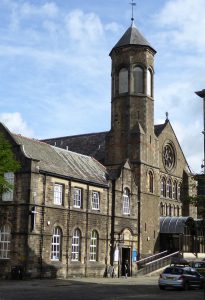
Sulyard Street Wesleyan Methodist Church, Lancaster
The largest of the Methodist churches to become a Lancaster LNU corporate member by 1928
© Janet Nelson
By 1928, 10 churches or church organisations and 3 civic districts had become corporate members of the Lancaster League of Nations Union (LNU). All these were nonconformist, showing how important nonconformity was to the LNU. The only Church of England church to join as a corporate member was St. Anne’s. This figure is double Helen McCarthy’s findings that in 1928 there were 5 times as many nonconformists as Church of England churches co-opted to their local branch nationally. (1)
There were 4 separate Methodist churches in Lancaster in 1928: Wesleyan Methodists (Sulyard St., Greaves and Skerton), Primitive Methodists (Moor Lane) the United Methodists (Brock St.) and Independent Methodists (Nelson Street). Though having doctrinal differences, they all collaborated with each other. By 1928, the three Wesleyans, the Primitives and the United Methodists had become LNU Corporate Members. The Independents were still not members in 1932, the date of the next list published in the Press. Of the Methodist clergy, Rev. J. W. Mountford was at the inaugural Lancaster LNU meeting in October 1920 and Rev. Ralph Tooth MA, who became a Vice-Chairman in 1925, was among the most active Lancaster LNU members. (2) On occasion, a church would invite a League of Nations Union speaker to its own meeting, such as when the Primitive Methodists had Tom Cape, the retiring MP for Workington and lay preacher, to talk to them on ‘Peace’ in 1923. (3)
References/Further reading:
(1) H. McCarthy, 2011. The British People and the League of Nations. Manchester: Manchester University Press, ch.3.
(2) Lancaster Guardian, 21 Apr 1928, 9 Oct 1920 & 21 Mar 1925.
(3) Lancaster Observer, 23 Nov 1923.

